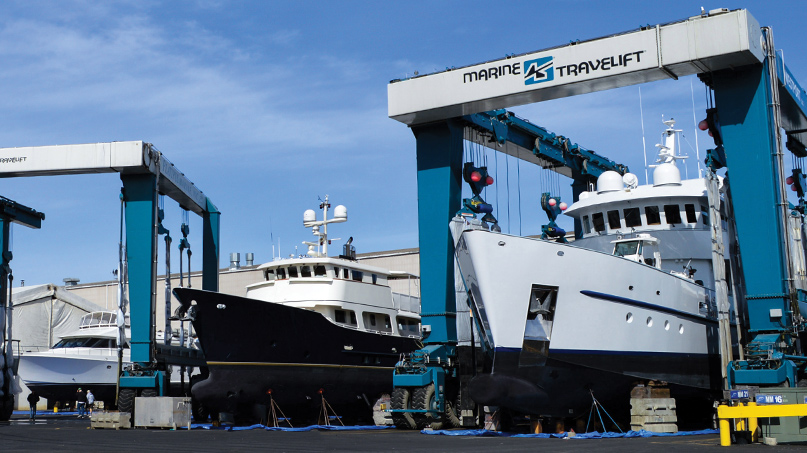
“Not everything that is more difficult is more meritorious.”
– Saint Thomas Aquinas
Rarely will docking the boat be a highlight of a day on the water, but it certainly has the potential to be a low point. We’ve all seen or been a part of the mad scramble as an incoming boat lumbers toward its slip a few feet (or yards) off-target with expensive property and public face on the line.
A stiff breeze or slight miscalculation can make the difference between keeping the smiles wide aboard and skyrocketing the collective blood pressure. Fortunately, a miracle of innovation delivered a not-so-secret weapon into the hands of boat drivers everywhere that has subtly changed docking and low speed maneuvers forever: thrusters!
A tactical set of bow and/or stern thrusters on a boat makes all the difference for many. Essentially a strategically placed propeller that enables sideways movement, a trusty thruster is a boater’s best friend. Off target? Not a problem, a few pulses of that thruster will put even large yachts back on course again, no emergency reverse required. Increasingly prevalent, and even standard, on boats these days, the thruster is an often appreciated but rarely examined system aboard.
To learn more about the world of thrusters, we turned to Captain Chris Feffer, the project manager of Port Angeles, Washington-based Platypus Marine Services, and Nigel Barron, a manager at Seattle’s CSR Marine Services.
With a lifetime of maritime credit under his belt, Capt. Feffer has overseen countless thruster-related projects on vessels in the government, commercial, fishing, and recreational spheres. Barron has been sailing and boating most of his life and has been at CSR for 15 years doing similar work on recreational vessels.
NWY: For the uninitiated, what exactly are the primary purposes of bow and stern thrusters aboard and what’s the basics of how they work?
Capt. Feffer: Simply put, bow thrusters are used primarily for docking and maneuvering in tight spaces. The basic concept is a propeller that is turned 180 degrees on the bow or stern so the vessel can easily maneuver side to side.
NWY: What kind of boat is best served with the addition of bow and/or stern thrusters? Large trawlers? Sailboats?
Barron: Really any vessel that needs to maneuver in tight spaces or in extreme wind and tide conditions could benefit from a bow thruster. Also, boaters who are not comfortable with docking and undocking can greatly benefit from bow and stern thrusters.
NWY: Is there a large variation in the types of thrusters on the market? How are boaters to pick what’s right for them?
Capt. Feffer: It depends on the size of vessel. In the 30’ to 50’ range, you have an option of electric or hydraulic. Anything over 50’ should be driven hydraulically to maximize thrust. Hydraulic thrusters typically have more thrusting power without overheating or running out of battery power.
NWY: Are thrusters becoming more common as standard aboard? They seem to be…
Barron: Based on what we’re seeing in the recreational and yacht markets, it’s becoming standard equipment on anything over 40’. The ones we’re installing tend to be on vessels where the existing systems can accommodate the addition of a bow thruster.
NWY: Is there a scenario where you’d recommend a bow over a stern thruster, or vice versa?
Capt. Feffer: 100 percent of the time you would have a bow thruster first then add a stern thruster to have more control over the vessel in tight docking situations. The stern of the vessel is easily controlled by the main propeller or propellers, which in turn sends the bow in the opposite direction of the stern.
Barron: More people are buying boats and marinas are using their space more wisely so boaters have to navigate tighter situations. A bow thruster allows you to more easily keep the bow parallel as you put the boat up to the dock.
NWY: Is there some kind of ratio when it comes to horsepower vs. size of vessel when it comes to choosing the right thruster for one’s boat?
Capt. Feffer: Each thruster manufacturer has a recommendation for the size of the thruster to be installed to the size of vessel. It never hurts to go a little bigger if you have the capacity to do so.
Barron: For hydraulic thrusters, the horsepower is determined by the hydraulic motor that is driving the bow thruster and whether it’s on the main engine or generator. The amount of horsepower the manufacturer says you can take from that engine will determine the horsepower of the thruster. With battery-powered bow thrusters, the horsepower is more determined by the manufacturer’s recommendations and the space available on the boat for the tube and/or the battery bank you’ll be using to drive the thruster.
NWY: What are the most common types of boaters coming into your yard who are getting thrusters installed?
Capt. Feffer: For us, pleasure yachts and commercial fishing vessels from 35’ to 60’. This seems to be the most common size range of boat that didn’t used to come with thrusters installed, but where owners and operators have found from driving other boats that thrusters are helpful to have aboard. I think this is a trend that will continue because as more companies have gotten into the bow thruster market it has brought down the overall cost of the unit to a range where people are installing them more often.
Barron: I agree with Chris. This is what we are seeing as well. What we like to tell people is that no one has ever come back and said, ‘My thruster works too well!’ or, ‘I wish I didn’t have a thruster!’ We’re also seeing a lot of people, because marinas are getting tighter with boats under 30’, that are just tired of bouncing around the marina. Also, as owners start to age, having the thruster with a remote means less jumping on and off the boat or running around.
NWY: What’s the process of installing a thruster? It’s a pretty big job, no?
Capt. Feffer: It’s not a small job. It requires access to the bow area so obstacles in the way like bunks or cabinets can make it more difficult. Cutting the bow and installing the tube is actually the easiest part of the job. Running hydraulic hoses or cabling and installing batteries is the most time-consuming part.
NWY: How far have thrusters developed in your time working on them? Are there any technological breakthroughs in the near-future?
Capt. Feffer: When thrusters went from single prop to dual prop that made a big difference in thrusting ability. Also, the integration of joy stick and remote controls for maneuvering the vessel makes it easier and safer for the captain and crew.
NWY: What’s the range in size of boats getting thrusters installed? Is there sort of a minimum and maximum length overall or tonnage, or not?
Capt. Feffer: Absolutely not, there is a bow thruster for every boat. We install a lot of bulbous bows on semi-displacement boats which helps with fuel economy, engine exhaust temperature, and pitch of the vessel. It’s really smart to put in a bow thruster during the installation of a bulbous bow to give you more maneuverability. At Platypus Marine, we deal with boats typically over 50’ and well over 50 tons. These take custom system design per bow thruster. Each bow thruster must be specially designed for the capacity of the hull design of the vessel.
Barron: Echoing what Chris was saying, there really is a thruster for every application and size of vessel. It’s not really limited to just cruising boats either. Some of the sailboats that are concerned about drag have opted for retractable bow thrusters. We’ve also found a use for retractable thrusters as an option for a stern thruster when there is just not a lot of transom in the water. As with any installation, it’s important to have a good plan in place as to where things will go. With the electric thrusters on the under 50′ boats, a key piece often overlooked is battery capacity. Electric thrusters are sensitive to voltage. A typical electric thruster is going to need at least 1400 CCA available. Glassing in the tunnel is also a big part of the install. It’s easy to just cut a tube in and move on, but a bevel on the leading edge is so important to mitigate drag.
NWY: Are there any specific thruster manufacturers that are offering new or exciting features with their products?
Barron: One thing that you can have now is a remote-control thruster, which means you can stand on your back deck and control the vessel with bow and stern thrusters for easier docking. It also makes solo landing your vessel easier.
Capt. Feffer: We don’t stick to one manufacturer. Every manufacturer has different options that the boat owner wants. A lot of times the boat owners already know what they want to have installed from visiting boat shows and speaking to the different manufacturers.
NWY: Are there any uniquely Pacific Northwest considerations, benefits, or concerns with regards to thrusters (maintenance, for example)?
Capt. Feffer: In the PNW, more marinas are using their spaces more wisely and slips are getting tighter which makes it challenging for boat owners. Also, the currents tend to run harder in certain marinas which makes it difficult to dock. However, owners should take into account that bow thrusters are one more mechanical item that needs servicing on a vessel.
Barron: Definitely, regular maintenance is required to maintain longevity of the thruster!





1 comment
I assume Capt. Feffer really meant thrusters are installed 90 degrees not 180 as that would make the in the same direction as the prop.